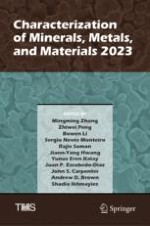The collection focuses on the advancements of characterization of minerals, metals, and materials and the applications of characterization results on the processing of these materials. Advanced characterization methods, techniques, and new instruments are emphasized. Areas of interest include, but are not limited to:
· Extraction and processing of various types of minerals, process-structure-property relationship of metal alloys, glasses, ceramics, polymers, composites, semiconductors, and carbon using as functional and structural materials.
· Novel methods and techniques for characterizing materials across a spectrum of systems and processes.
· Characterization of mechanical, thermal, electrical, optical, dielectric, magnetic, physical, and other properties of materials.
· Characterization of structural, morphological, and topographical natures of materials at micro- and nano- scales.
· Characterization of extraction and processing including process development and analysis.
· Advances in instrument developments for microstructure analysis and performance evaluation of materials, such as computer tomography (CT), X-ray and neutron diffraction, electron microscopy (SEM, FIB, TEM), and spectroscopy (EDS, WDS, EBSD) techniques.
· 2D and 3D modelling for materials characterization.
